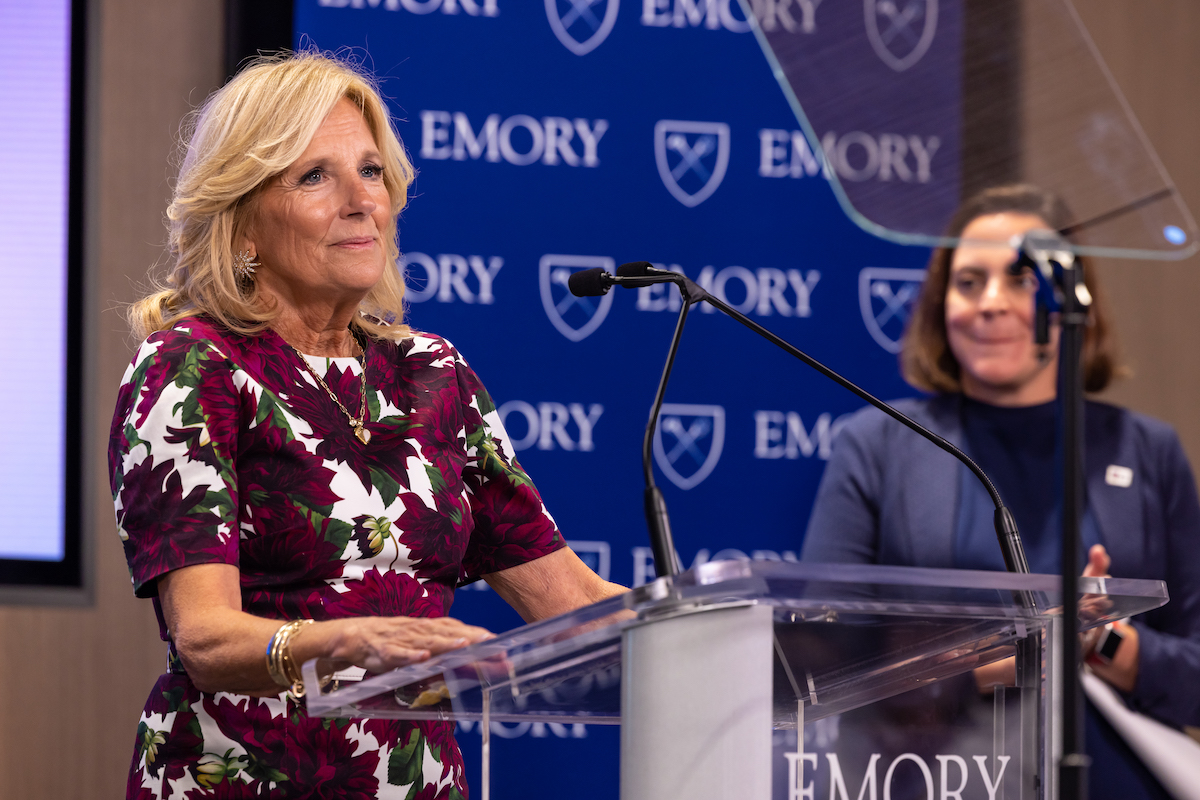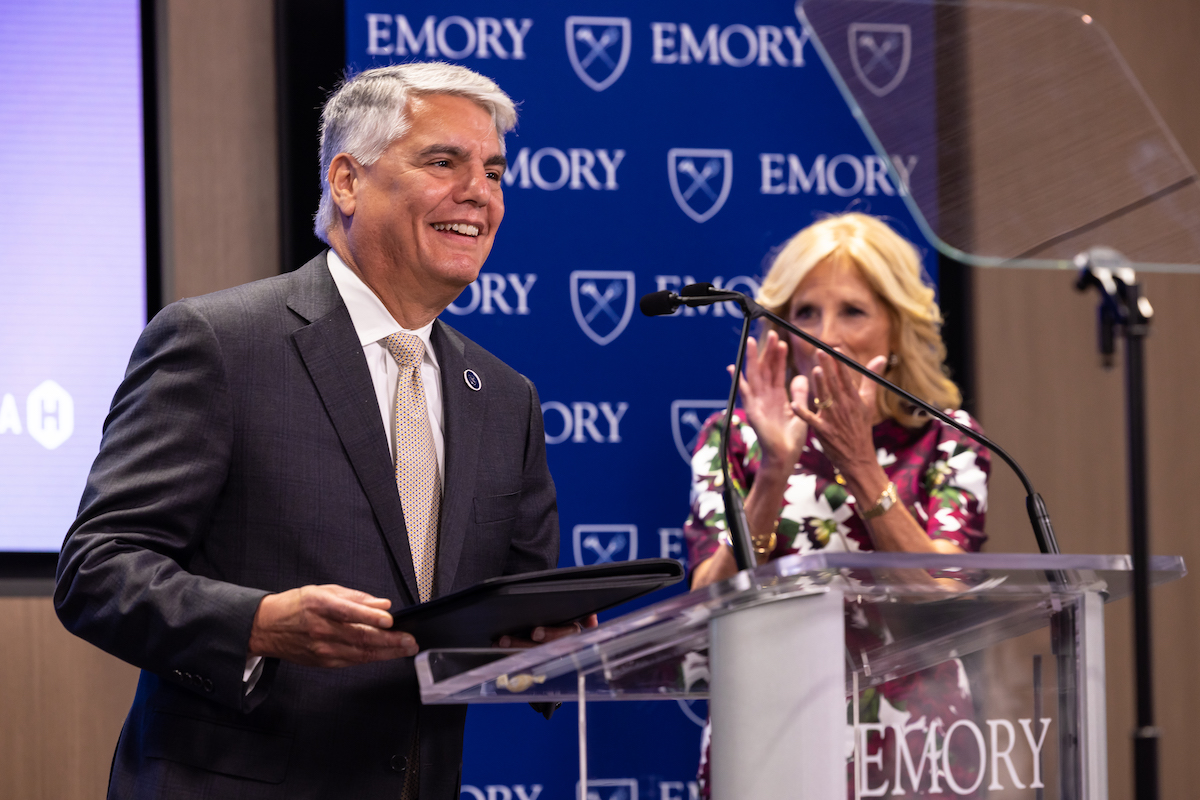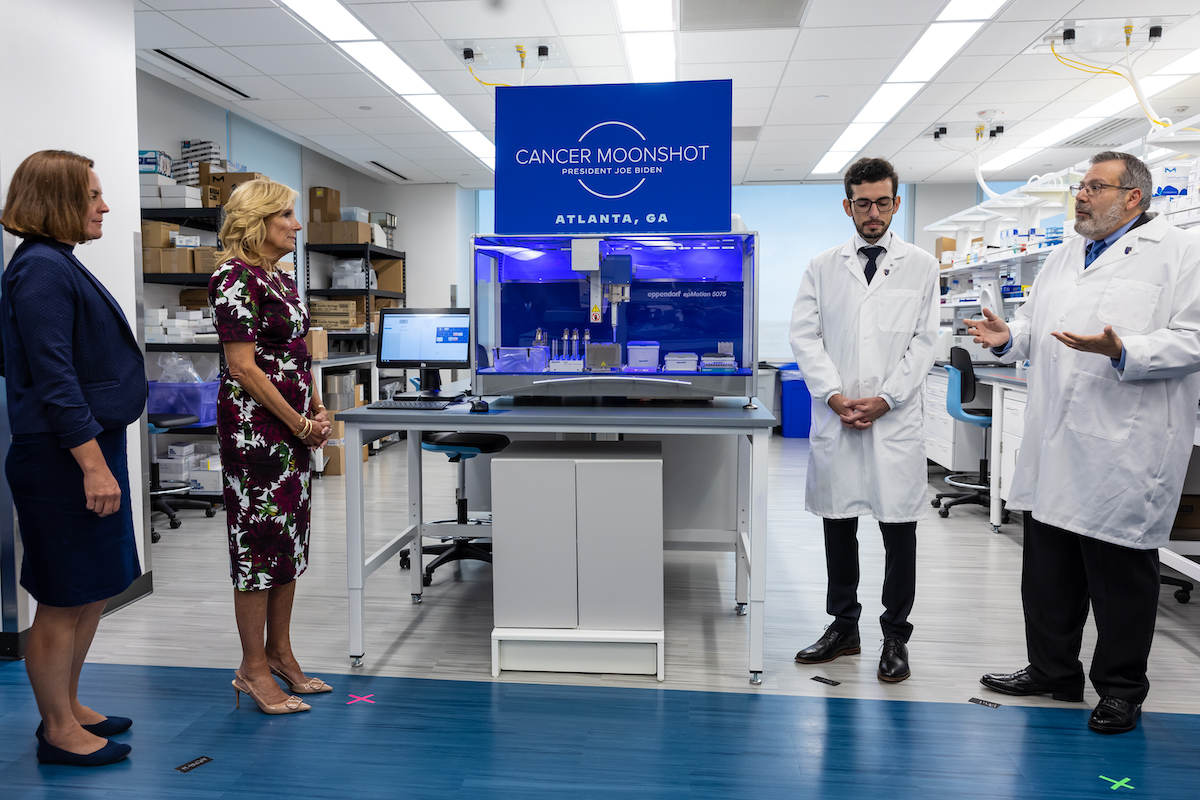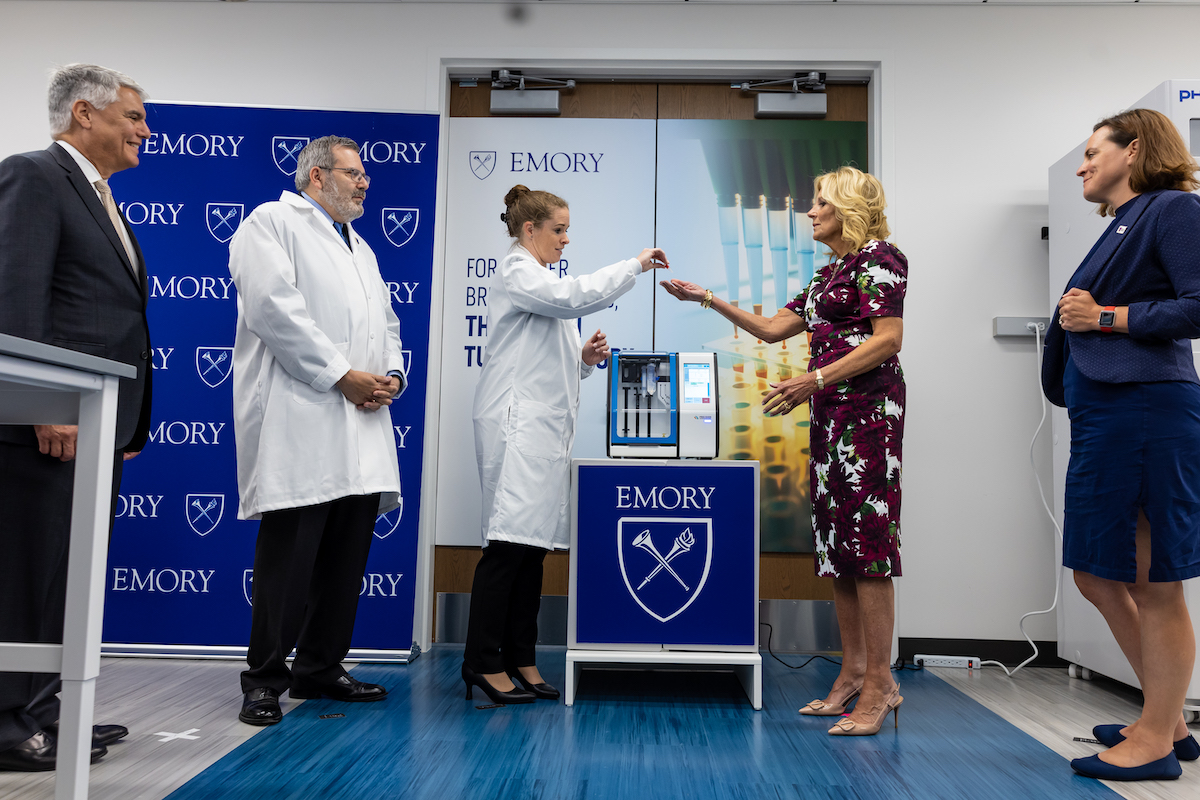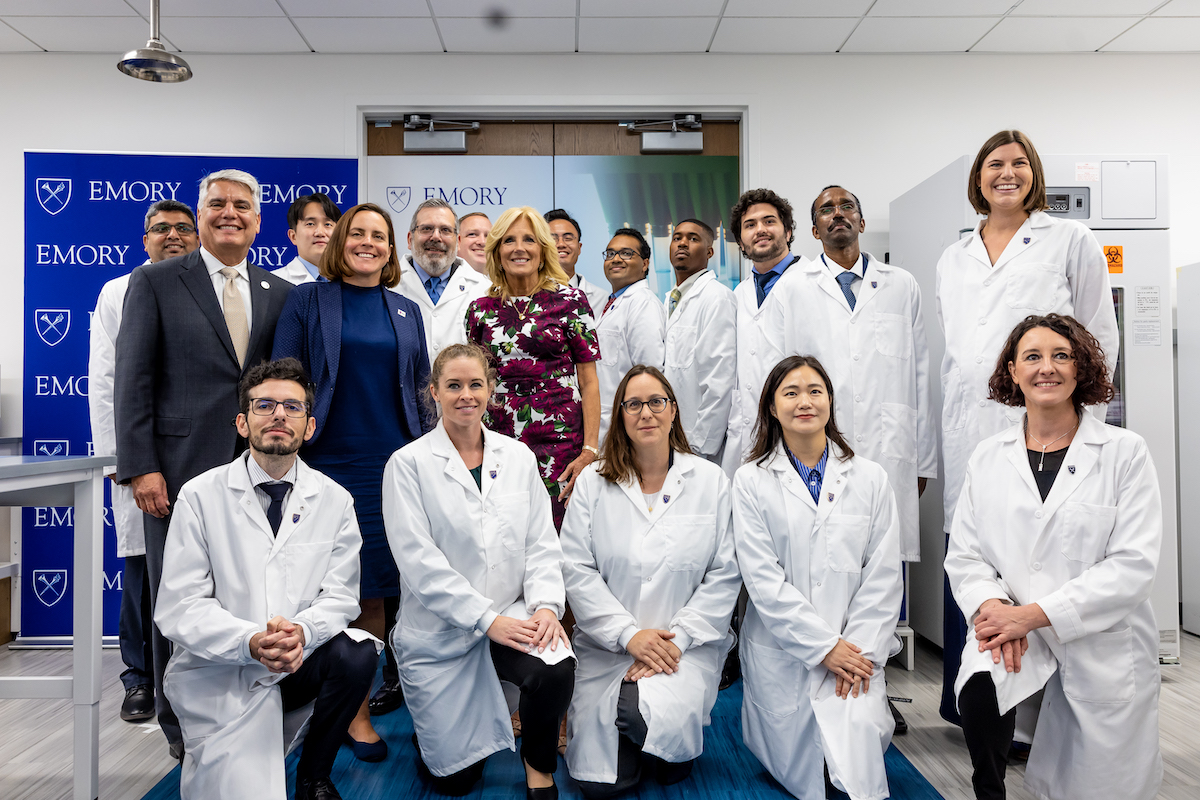First lady Jill Biden visited Emory University Sept. 15 to learn about groundbreaking research focused on training the immune system to treat, prevent and cure cancers and other diseases. Biden toured the lab of Emory professor Philip Santangelo, whose team is working to develop new mRNA-based drugs to “turn on” or “turn off” genes in individual immune cells.
“As a mom who watched my son die of cancer, the one thing I never gave up on was hope. As a mother, you can’t,” Biden said after the tour. “This work gives families the power to hold on to that hope just a little bit longer. Because this work could change lives.”
Last month, President Joe Biden announced that a new federal agency within the U.S. Department of Health and Human Services has selected Emory as the first recipient of new funding to support transformative biomedical and health breakthroughs. The three-year, $24.8 million cooperative agreement from the Advanced Research Projects Agency for Health (ARPA-H) supports the goals of the Biden Cancer Moonshot.
“Over the past few years, COVID-19 vaccines developed using mRNA technology have saved millions of lives around the world,” the president said in the announcement. “Now, a skilled team at Emory University in Atlanta will work to adapt these technologies to turn more cancers into curable diseases. This is a bold endeavor that has the potential to transform the fight against cancer and other difficult diagnoses.”
Tuning the immune system
Santangelo is a professor in the Wallace H. Coulter Department of Biomedical Engineering at Emory and Georgia Institute of Technology, and a researcher at Winship Cancer Institute of Emory University.
During Friday’s visit, the first lady and ARPA-H Director Renee Wegrzyn joined Emory President Gregory L. Fenves on a tour of Santangelo’s lab to learn more about his goal of developing new mRNA-based drugs to precisely “turn on” or “turn off” genes in immune cells.
With many chronic infections and diseases, including many forms of cancer, the immune system is suppressed or dysregulated — allowing cancer cells to multiply unchecked, for example, or, in the case of organ transplantation, attacking healthy cells that the body needs.
“What we have zeroed in on is that one of the commonalities among many, many diseases that afflict Americans is immune dysregulation. That is important in cancer, autoimmune diseases and other diseases,” Santangelo said during the tour. “So we want to basically develop mRNA drugs that would allow us to tune the immune system.”
This molecular “toolbox” could be used to manipulate how a patient’s immune system functions, prompting it to target and attack tumor cells, or to tolerate transplanted organs — without the severe side effects that are common with more traditional treatments like chemotherapy.
During the tour, Biden and Wegrzyn received a firsthand look at some of the initial steps in the discovery process.
José Assumpção, a postdoctoral fellow in the Santangelo Lab, demonstrated a machine that uses a robotic arm to transfer mRNA candidates and mix them with immune cells for testing — “basically how we discover new RNA molecules that are part of the bigger drug, but they themselves are not the drug,” Santangelo explained.
Lab manager Loren Sasser then demonstrated a formulation device that mixes the candidate mRNAs with a drug carrier. After more processing, the end result would be a new treatment ready for testing.
“Getting those into clinical trials, really being able to get that out to people, is something that is extremely challenging,” Santangelo said during the tour. “Having partners in government, in industry and across the landscape is going to be incredibly important. We can’t do this alone, and that’s why the Cancer Moonshot and the support from the administration is huge — because it’s the only way to fuel this kind of work.”
‘Curing the uncurable’
After the tour, Biden, Wegrzyn and Fenves spoke to the press about the potentially life-saving impact of Emory’s work on the project, dubbed CUREIT — Curing the Uncurable via RNA-Encoded Immunogene Tuning.
“We just came from touring the lab, and it’s incredible to see how pieces of this project come together, testing thousands of possibilities to find the one that could change our world,” Biden said.
The Biden Cancer Moonshot, she noted, takes its inspiration from the United States’ efforts after the launch of the Sputnik satellite in 1957 — “to launch bold ideas with lightning speed, to give scientists and engineers the freedom to reach beyond the possible, to unravel the unknown.”
"Just two weeks ago, ARPA-H made its first award to a research team right here at Emory. And as we just saw, they are finding ways to train our immune systems to fight cancer and other diseases. And that is the heart of the Biden Cancer Moonshot,” she said.
“Your work can change lives here in Georgia and around the world,” Biden continued. “Through the Cancer Moonshot, we’re putting American innovation to work for patients. And together, we will make it so the word ‘cancer’ loses its power, so fewer families know the pain of losing a loved one to this disease. It’s ambitious, yes, but it’s within our reach.”
As director of ARPA-H, Wegrzyn said she is excited to celebrate the “remarkable partnership” between Emory and the new agency, “which marks the beginning of a transformative journey towards advancing health care for all Americans.”
“The Emory team is bringing to life an ambitious vision to use mRNA to activate and directly tune the beneficial immune system to levels that are most effective, in a way that today's vaccines and current approaches simply cannot,” Wegrzyn said. “The RNA technology employed by CUREIT is a versatile platform that can revolutionize treatments for various conditions from lupus to transplant rejection, and even infectious diseases like long COVID.”
Fenves thanked Biden and Wegrzyn for putting their trust in Emory “and for working so hard to bring treatments, cures and research solutions to the American people with tremendous vision and speed.”
Receiving the first grant from ARPA-H is both a huge honor and a reflection of the way Emory approaches its mission, he noted: “At Emory, it isn’t enough to simply accomplish something great, to reach a goal or earn recognition. We measure our success through lives changed and lives saved.”
The new biomedical technologies being developed by Santangelo’s research team are “nothing short of revolutionary. And with this funding from ARPA-H — and its mission to not only develop cutting-edge cures and treatments, but to speed up the process of making these breakthroughs available to the public, from the lab to the bedside — we are going to save lives here in Georgia and across the country,” Fenves pledged.
The Santangelo Lab is collaborating with other researchers from Emory University and Winship Cancer Institute (John Lyons, Inaki Sanz, Christian Larsen and Rafi Ahmed), as well as researchers from Yale University (Richard Edelson), the University of Georgia (R. Jeff Hogan and Eric Lafontaine) and Transimmune AG (Justin Duckworth) on the CUREIT project.
Photos by Sarah Woods, Emory Photo/Video.


